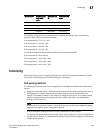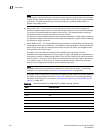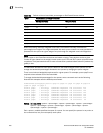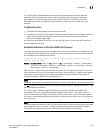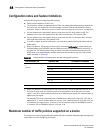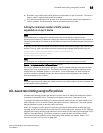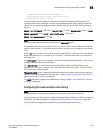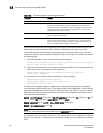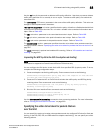
PowerConnect B-Series FCX Configuration Guide 611
53-1002266-01
Chapter
18
Configuring Traffic Policies
Table 106 lists the individual Dell PowerConnect switches and the traffic policy features they
support.
Traffic policies overview
This chapter describes how traffic policies are implemented and configured in the PowerConnect
devices.
Dell devices use traffic policies for the following:
• To rate limit inbound traffic
• To count the packets and bytes per packet to which ACL permit or deny clauses are applied
Traffic policies consist of policy names and policy definitions:
• Traffic policy name – A string of up to eight alphanumeric characters that identifies individual
traffic policy definitions.
• Traffic policy definition (TPD) – The command filter associated with a traffic policy name. A
TPD can define any one of the following:
• Rate limiting policy
• ACL counting policy
• Combined rate limiting and ACL counting policy
The maximum number of supported active TPDs is a system-wide parameter and depends on
the device you are configuring. The total number of active TPDs cannot exceed the system
maximum. Refer to “Maximum number of traffic policies supported on a device” on page 612.
When you apply a traffic policy to an interface, you do so by adding a reference to the traffic policy
in an ACL entry, instead of applying the individual traffic policy to the interface. The traffic policy
becomes an active traffic policy or active TPD when you bind its associated ACL to an interface.
To configure traffic policies for ACL-based rate limiting, refer to “Configuring ACL-based fixed rate
limiting” on page 614 and “Configuring ACL-based adaptive rate limiting” on page 615.
To configure traffic policies for ACL counting, refer to “Enabling ACL statistics” on page 619.
TABLE 106 Supported traffic policy features
Feature PowerConnect B-Series FCX
Traffic policies Yes
ACL-based fixed rate limiting Yes
ACL-based adaptive rate limiting Yes
802.1p priority bit inspection in the ACL
for adaptive rate limiting
Yes
ACL statistics Yes



